Treason Trial
After September 11, 1851, authorities arrested dozens, and the federal government charged 38 with treason in an attempt to squash the Underground Railroad. They held the accused at Moyamensing prison in Philadelphia and put them on trial at Independence Hall. The Christiana Treason Trial started with the prosecution of Castner Hanway, one of William Parker’s white neighbors. Testimony revealed the role of Underground Railroad spy Samuel Williams, who had relayed Gorsuch's plans to Christiana. Because even the judge said there was no basis for treason, the jury acquitted Hanway in fifteen minutes. The government then dropped the rest of the charges. The outcome produced fiery propaganda from pro- and anti-slavery newspapers and signaled to many that the fight for freedom might become a civil war.
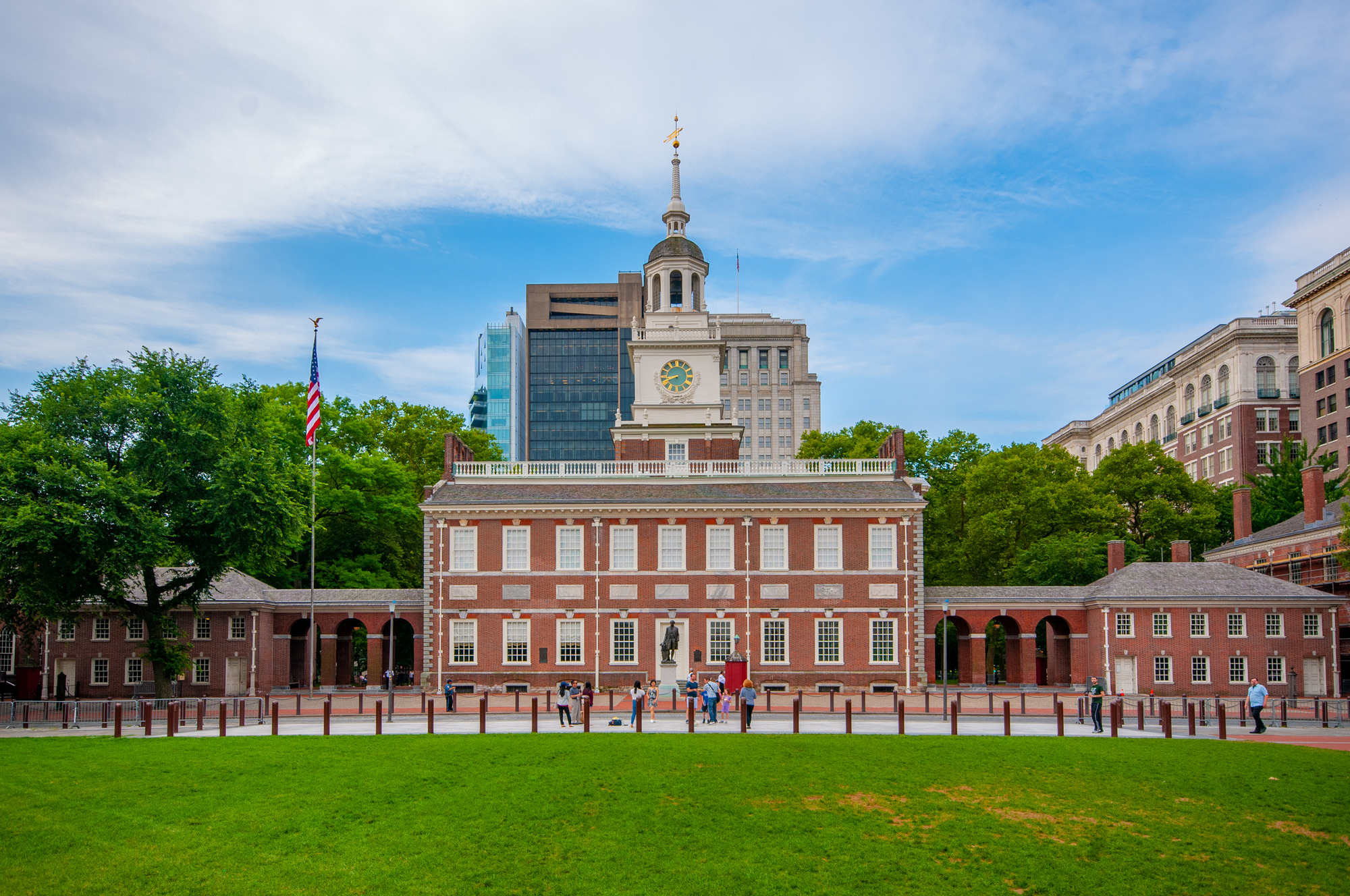
(Credit: National Park Service)
Timeline
November 24, 1851: Treason trial begins in Philadelphia at federal court in Independence Hall.
December 11, 1851: Federal jury acquits Castner Hanway of treason.
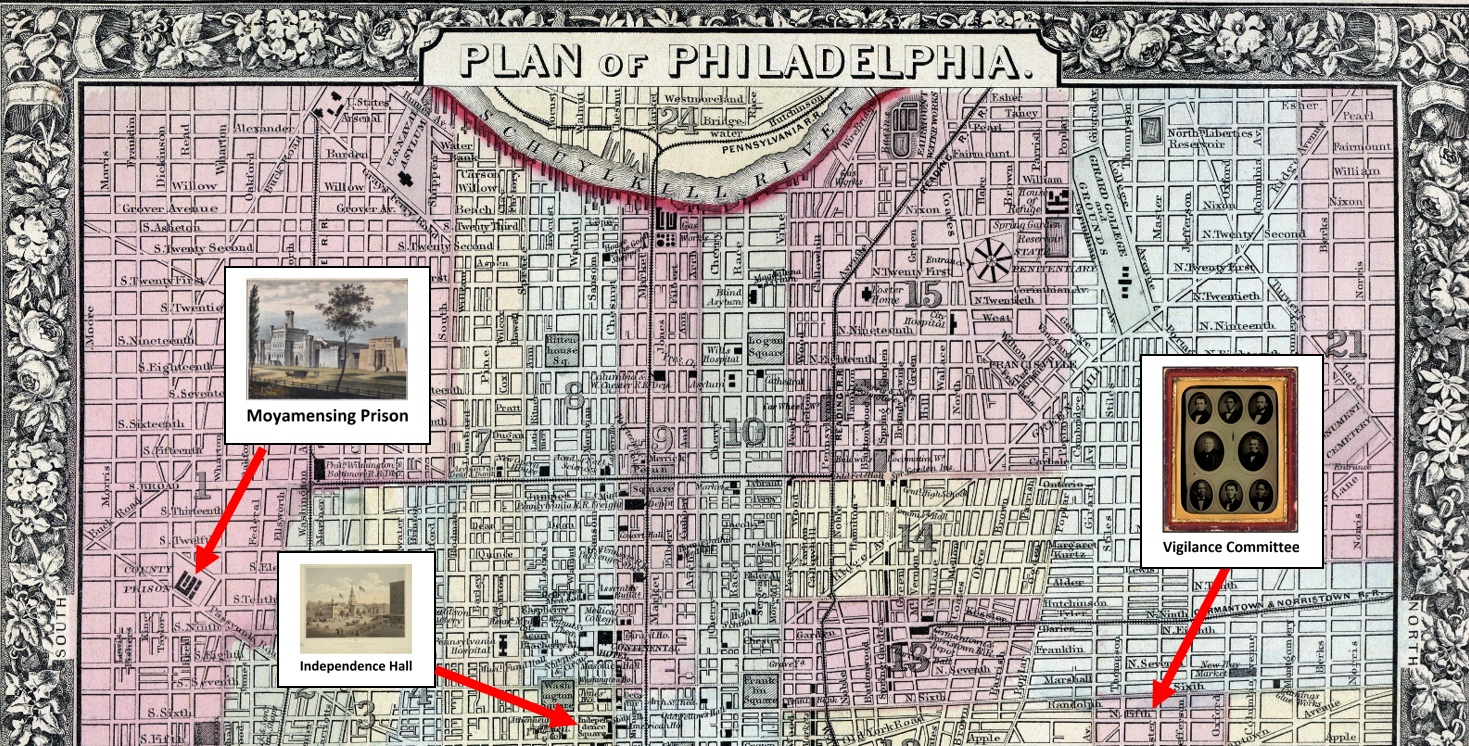
(Credit: 1857 map from House Divided Project at Dickinson College)
Background
Arrests
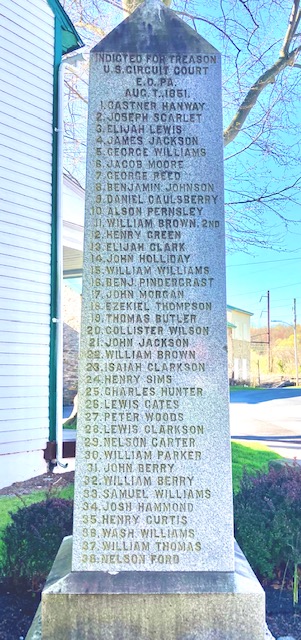
Christiana Memorial (Aiden Pinsker)
The Trial
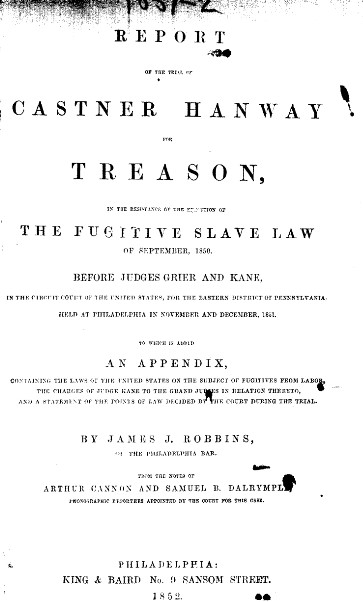
(Library of Congress)
The Verdict
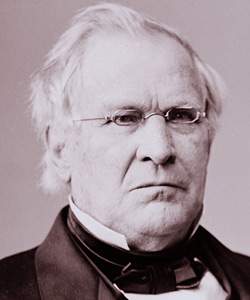
Justice Robert Grier (House Divided Project at Dickinson College)
Arrests
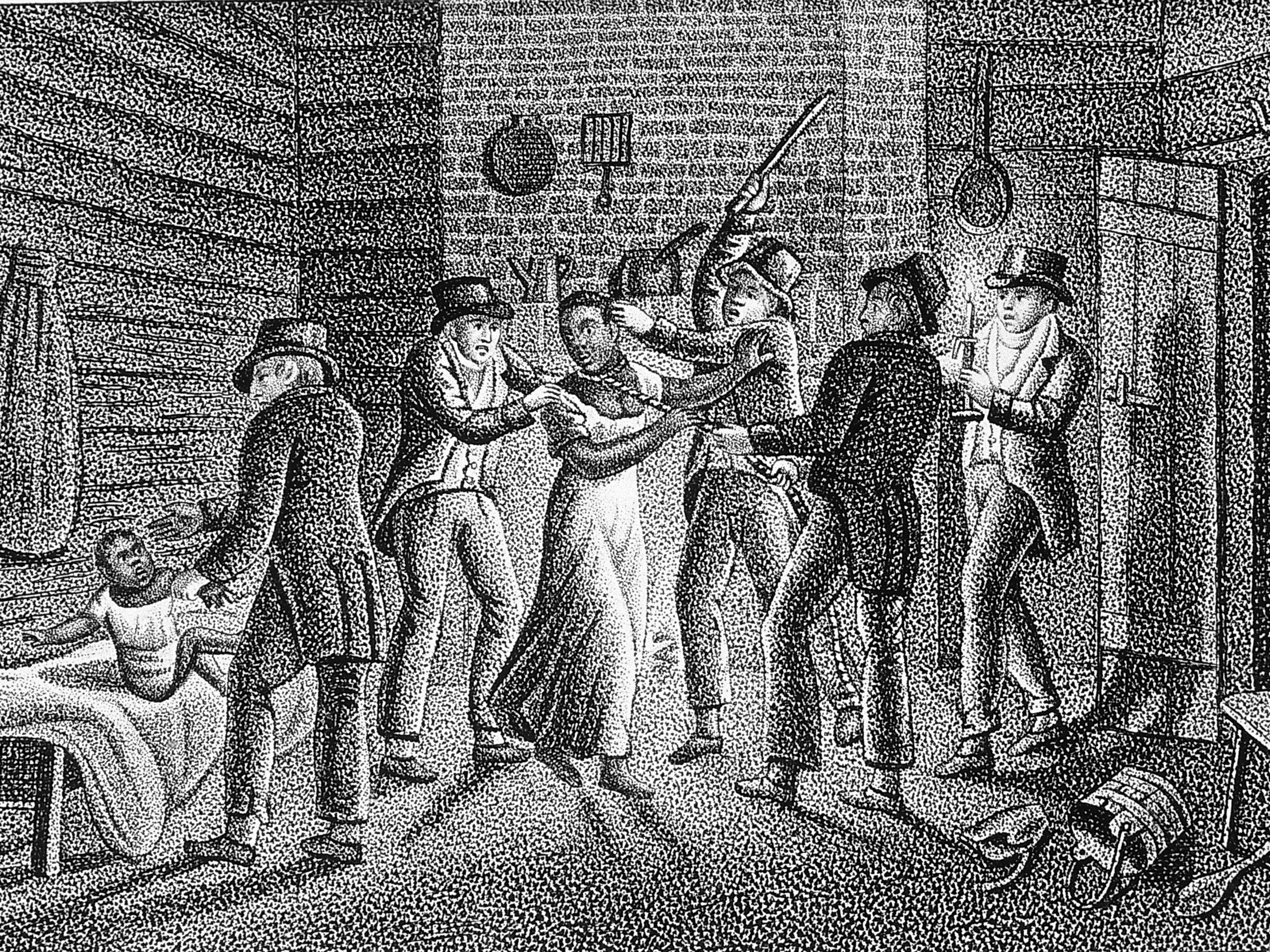
(thoughtco.com)
“It was not until the day after the battle, Friday, September 12, that Marshal Kline went before Christiana Justice of the Peace Joseph D. Pownall to begin the first official proceedings against the resisters. On that morning, the marshal, on oath, named and charged seventeen men, fifteen blacks and two white, with ‘aiding and abetting in the murder of Edward Gorsuch.’ Warrants were issued for the arrest of the seventeen men named.”
--Johnathan Katz, Resistance at Christiana (1971) p. 122.
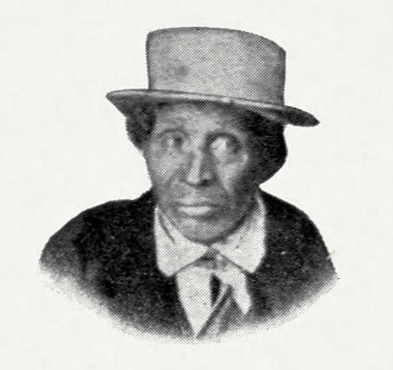
Ezekiel Thompson (LincolnConspirators.com)
“In Lancaster itself, a posse of about fifty locals was assembled by 10 p.m. on the night following the riot and was supplemented over the course of the evening by ‘gangs of armed ruffians’ from Maryland, who were even more eager to vent their anger over Gorsuch’s death on the black and white citizens of Lancaster County. ‘Wo to them who resist!’ was the motto of this outraged assemblage of white men from Baltimore and Lancaster County and an accurate reflection of the thirst for revenge that would inspire their actions over the next couple of days.”
--Thomas P. Slaughter, Bloody Dawn (1991), p. 86, 87
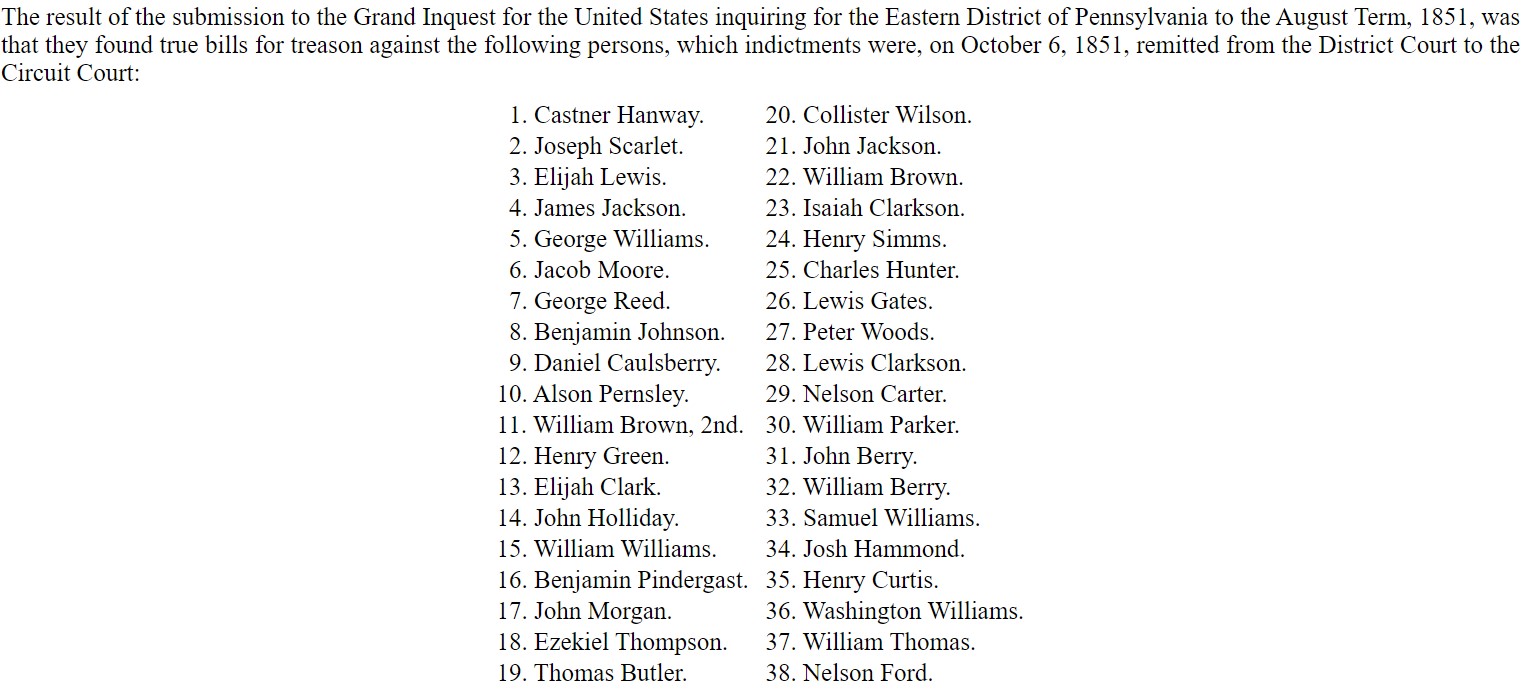
--William Hensel, The Christiana Riot and Treason Trials of 1851 (1911) p.59
The Trial
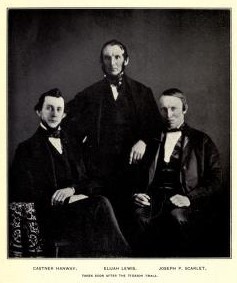
Christiana defendants, Castner Hanway seated left (archive.org)
“The array of lawyers on both sides was impressive. The prosecution counsel of seven included Attorney General of Maryland Robert J. Brent; U.S. Senator from Pennsylvania James Cooper; U.S. Attorney for the Eastern District of Pennsylvania John W. Ashmead; his cousin, an attorney of Philadelphia, George L. Ashmead; Philadelphia City Recorder R. M. Lee; District Attorney Z. Collins Lee of Baltimore; and Philadelphia lawyer James R. Ludlow.”
--Johnathan Katz, Resistance at Christiana (1971) p. 178.
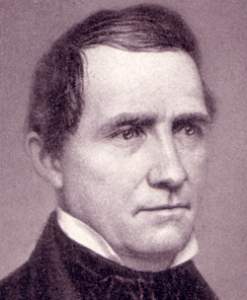
Prosecutor John W. Ashmead (House Divided Project at Dickinson College)
"The defense team included, in addition to Congressman Stevens, a 'Woolly Headed Whig' serving his second term in Congress; John M. Read, who was a Democrat; Joseph J. Lewis, from Chester County; and the Philadelphia lawyer Theodore Cuyler. These men were, by general agreement among commentators, 'four of the most prominent lawyers of the State.' They were joined at the defense table by their juinor counsel W. A. Jackson, who later wrote his own 'history' of the case in response to Brent's Report, and abolitionist lawyer David Paul Brown, who represented several other defendants in the Christiana Riot case."
--Thomas P. Slaughter, Bloody Dawn (1991), p. 225
“From Ashmead’s perspective, the government needed every political-advantage, legal, and tactical-that he could manufacture, because the prosecution was the decided underdog in the case. All the resources of the abolition network were arrayed against him; no expense was being spared to assemble the best legal talent available in Hanway’s behalf. Defense lawyers had the resources to investigate the background and views of prospective jurors from the rural countryside surrounding Philadelphia…”
--Thomas P. Slaughter, Bloody Dawn (1991), p. 116
The Verdict
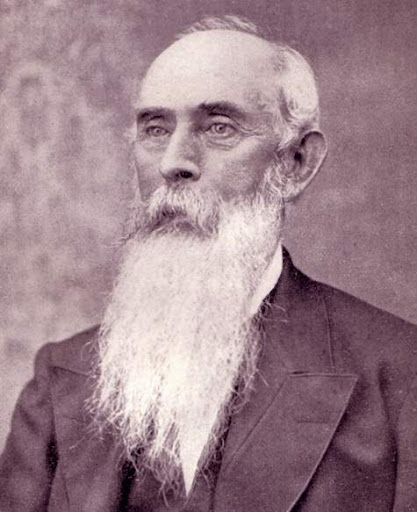
Castner Hanway (House Divided Project at Dickinson College)
“The judges statement came on December 11, eighteen days after the trial had begun. ‘The evidence has clearly shown,’ proclaimed Judge Grier, ‘that the participants in this transaction are guilty of riot and murder at least.’ But Castner Hanway was charged with treason; the other crimes were matters of the state courts. Grier also spoke on the question of treason, and in his opinion, the jury would have to acquit: ‘Not because the numbers or force was insufficient. But 1st, For want any proof of previous conspiracy to make a general and public resistance to any law of the United States.’”
--Thomas P. Slaughter, Bloody Dawn (1991), p. 133
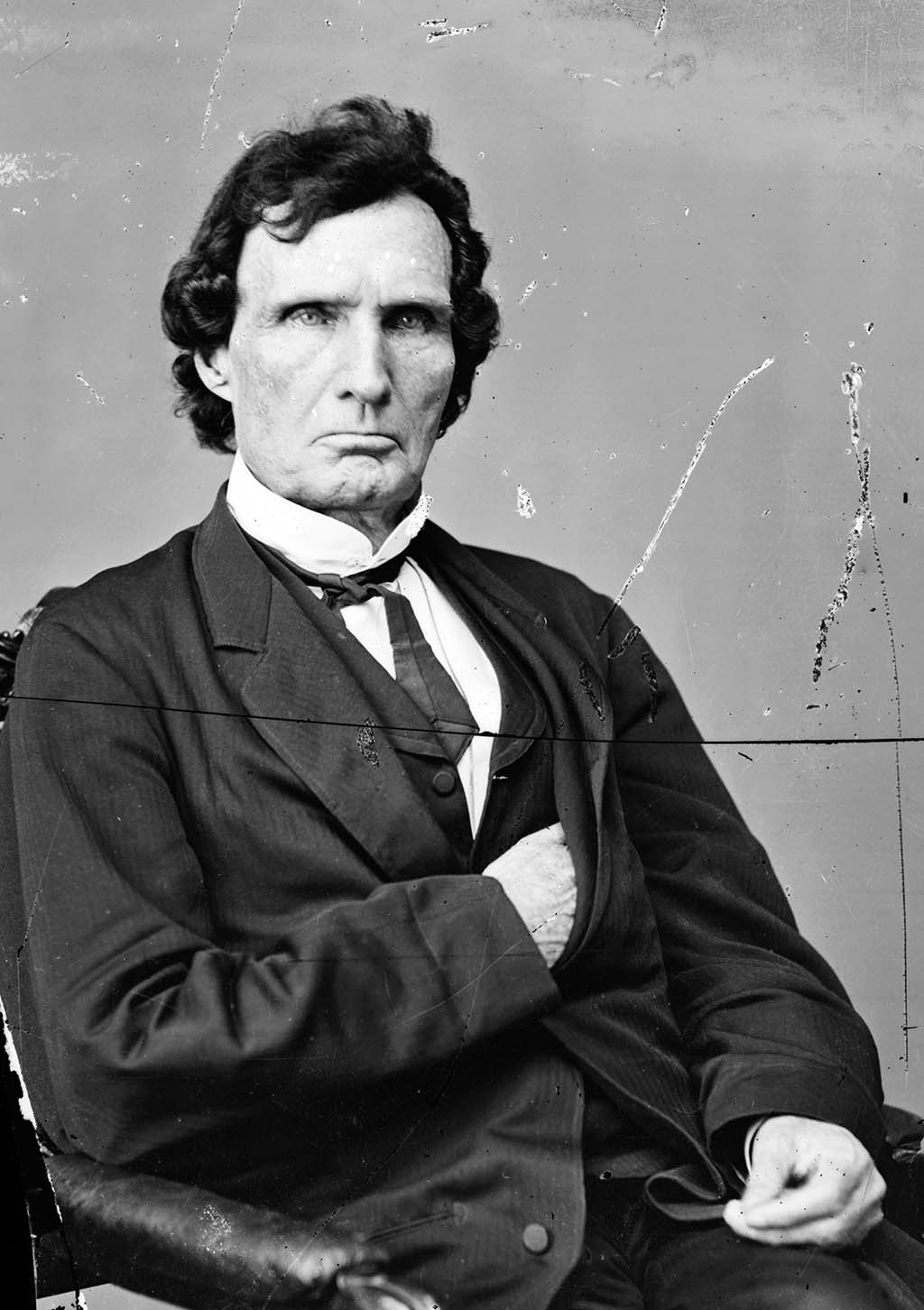
Defense attorney Thadeus Stevens (balckpast.org)
“Fourteen days later, on the last day of December, 1851 Marshal Anthony Roberts transported some of the black prisoners from Philadelphia to Lancaster prison. U.S. Attorney Ashmead’s fears of Lancaster County leniency were justified. Lancaster District Attorney John L. Thompson found evidence insufficient to warrant the prisoners’ detention. Nine black prisoners transferred to Lancaster on December 31 were discharged that very evening.”
--Johnathan Katz, Resistance at Christiana (1971) p. 235
“The verdict found by the jury on the damage of treason and the lack of charges against those who had caused the death of Edward Gorsuch and the severe wounding of his son, Dickinson, left a very sour taste in the mouths of Southerners that continued through the decade leading up to the Civil War.”
--L.D. Rettew, Treason at Christiana (2006) p. 112.
Primary Sources
Propaganda
Pro-Slavery
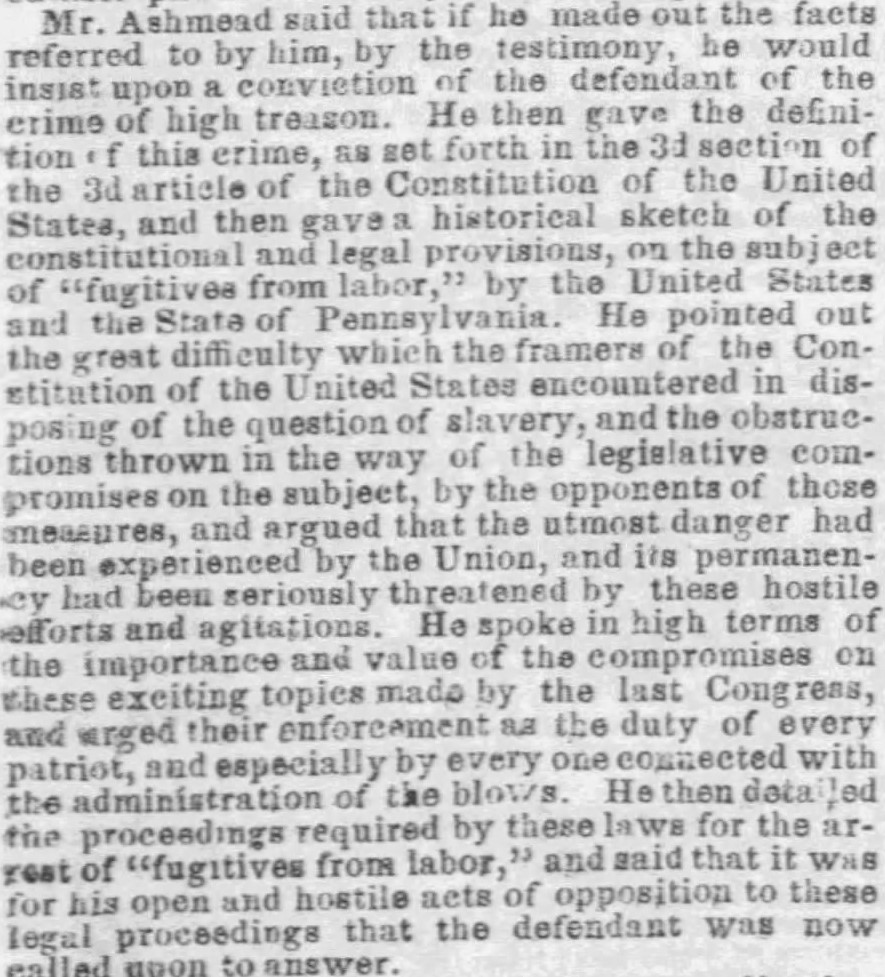
Baltimore Sun November 29, 1851
“[Ashmead] pointed out the great difficulty which the framers of the Constitution of the United States encountered in the disposing of the question of slavery, and the obstructions thrown in the way of the legislative comprises on the subject, by the opponents of those measures, and argued that the utmost danger had been experienced by the Union, and its permanency had been seriously threatened by these hostile efforts and agitations.”
--Baltimore Sun, November 29, 1851
Anti-Slavery
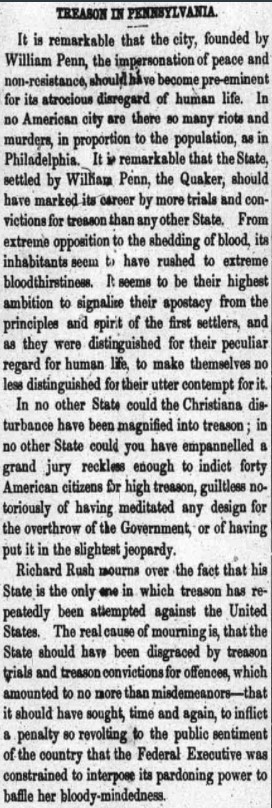
The National Era, November 27, 1851
“In no other State could the Christiana disturbance have been magnified into treason; in no other State could you have empaneled a grand jury reckless enough to indict forty American citizens for high treason, guiltless notoriously of having mediated any design for the overthrow of the Government, or of having put it in the slightest jeopardy. Richard Rush mourns over the fact that his State is the only one in which treason has repeatedly been attempted against the United States. The real cause of mourning is, that the State should have been disgraced by treason trials and treason convictions for offences, which amounted to no more than misdemeanors…”
--The National Era, November 27, 1851
Trial Transcript
Testimony Reveals Secret Communication From Resistance
"The fact that the writs had been issued, became known to a colored man living in this city, named Samuel Williams, who preceded the officers to the neighborhood where the slaves resided, and where the arrests were to have been made, and gave notice that they were coming to execute them... 'I knew him by the description of the same roundabout, and the straw hat.'"
--James Robbins, Report of the Trial of Castner Hanway for Treason p. 47, 50
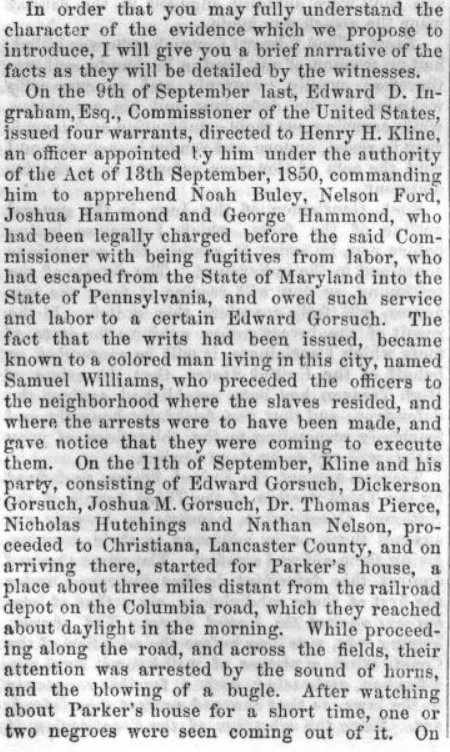
Christiana Treason Trial Transcript (James Robbins, Report of the Trial of Castner Hanway for Treason)
Defense Lawyer Seeks More Witnesses
Phila. Nov. 10 /[18]57
Dear Sir,
You spoke to me the other night of evidence which you thought might be had in the valley to prove the whereabouts of Nelson Ford at the time of the riot. If such testimony could be obtained with regard to him or any other of Gorsuch’s slaves it would be of great importance and we would be much indebted to you if you would make such inquires as you can and write to me as soon as possible the result as to the following points—
1. Where Nelson Ford, Joshua Hammond, or either of the other slaves were that night?
2. Who occupied Parker’s house in general?
3. Who were in it that night
4. How long Parker, Pinckney, and Johnson have lived in Pennsylvania?
I ventured to ask this favor of you because I know you are anxious to do everything you safely can for the prisoners. Of course the testimony I want must come from others than your own family.
Very truly yours,
W. Arthur Jackson
No. 33 South 5th St Philadelphia
-- Letter from W. A. Jackson, November 10, 1857, transcript by Aiden Pinsker with parental help for some cursive. Christiana Resistance Collection, Lancasterhistory.org
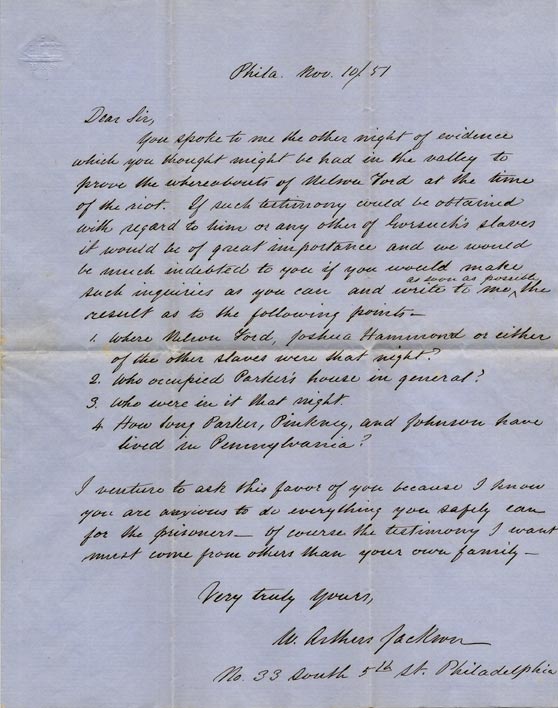
(Citation: Letter from W. A. Jackson, November 10, 1857. Christiana Resistance Collection, Lancasterhistory.org)
Parker Descendant Describes Trial's Impact
--Michele Parker Samuels, zoom interview, April 17, 2021